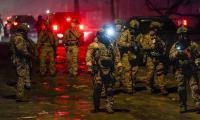Uri attack is an addition to RAW failures
Indian intelligence agency could not save Mujeebur Rehman; it could not forewarn Indira Gandhi of the consequences of emergency; it could not warn and save Rajiv; it could not preempt umpteen gory incidents in many cities; it has to its ‘credit’ many pseudo operations like hijacking of Ganga plane, Pathankot operation
By Sabir Shah
LAHORE: Assisted by its crafty media, the Indian political and security establishment is notorious for designing bizarre pseudo operations so that it could defame Pakistan in the eyes of the world, muster international support and to cover up its intelligence failures, but on most occasions over the years, even the internal investigative reports have mocked New Delhi’s claims in this context.
Now, just a day before the Pakistani Premier Nawaz Sharif was gearing up to address the United Nations General Assembly (UNGA) and apprise the world of the Indian atrocities in Held Kashmir, those at the helm of affairs in New Delhi have yet again accused Pakistan of attacking a military camp in Occupied Kashmir without any substantial proof.
Well, India keeps spelling out this rhetoric and the timing of airing such concocted and fabricated fairy tales is extremely significant. In the most recent case, New Delhi explicitly wishes to dilute the effects of Nawaz Sharif’s speech at the United Nations.
India’s false flag operation at Pathankot:
On January 2 this year, after the Pathankot Air Base in Indian Punjab was reportedly/allegedly attacked by militants, a banned outfit “Jaish-e-Muhammad” was promptly blamed by key government functionaries in New Delhi, instead of first apprehending the miscreants and carrying out the necessary combat operations to clear the facility.
Internal probe throws egg on Indian government’s face:
On June 2, 2016, as “Zee News” had reported, the Director General of Indian National Investigation Agency (NIA) Sharad Kumar said that there was no evidence to indicate the direct complicity of the Pakistani government or the Pakistani agencies at the Pathankot attack.
The “Zee News” had quoted Kumar as saying: “No evidence suggests that Pakistan government or Pakistani government agency was helping Jaish–e–Mohammed or Masood Azhar or his aides to carry out Pathankot attack.”
The Indian media outlet had further gone on to quote DG Kumar on the issue:
“At the same time, there is sufficient and stringent evidence against Masood Azhar and his brother Rauf Azhar and we will include those proofs in our charge-sheet."
Following Director General Kumar’s statement, the Ministry of Foreign Affairs in Islamabad said the Indian inquiry had vindicated Pakistan's longstanding position in the context of Pathankot.
The statement by the Pakistani Foreign Office had added, "The spirit of cooperation is manifested in the action we (Pakistan) took in the wake of the alleged incident."
Pathankot incident timing:
It is worth recalling that the Pathankot air base attack had occurred just days after Indian Prime Minister Narendra Modi had paid a 'surprise' visit to Prime Minister Nawaz Sharif on his birthday and the occasion of his granddaughter's wedding; a move that appeared to promise better relations between the two nuclear rivals.
The alleged 1971 plane hijacking to support Mukti Bahini in East Pakistan:
Research reveals that on January 30, 1971, the Indian spy agency RAW had conducted a false flag operation by making its operatives hijack a Fokker “Ganga” from India to Lahore.
The Indian government had immediately said Kashmiri militants, Hashim Qureshi and Ashraf Butt, were behind the hijacking.
It had disallowed Pakistani aircraft from using its air space forthwith. Pakistani planes could no longer fly to the restive East Pakistan (later Bangladesh).
On February 1, 1971, the passengers and crew of “Ganga” were released in Lahore and the aircraft was burnt.
Interestingly, the Indian Airlines plane “Ganga” was already withdrawn from service but was re-inducted days before the hijacking.
The events that followed showed that the purpose behind this false flag operation was to cut off east-west air flights of Pakistan so as to give free hand to Mujibur Rehman and his cronies to speed up their secession plan and create Bangladesh.
This overflight ban in the run up to the December 1971 Indo-Pak War later had a significant impact on troop movement into erstwhile East Pakistan as Islamabad had to send reinforcements through a longer air route via Colombo.
East Pakistan thus remained cut off from West Pakistan till the very end and the “hijacking” enabled Indian armed forces to fuel the insurgency.
(Reference: Indian Colonel Anil Athale’s June 2, 2005 article for a media house Rediff.com)
From 2001 till 2008, Pakistan was held responsible for most acts of terror taking place on Indian soil.
These events included the Samjhota Express train blasts killing over 50 Pakistanis, the bombing in Mecca mosque of Hyderabad Deccan and a 2008 blast in a Malegaon (Maharashtra state) mosque.
The November 26, 2008 Mumbai attack is yet another candid example of Indian false flag operations, aimed at deflecting the attention of the world from the unabated genocide in Occupied Kashmir, create a stir to pressurise Pakistan.
Hemant Karkare, the chief of the Maharashtra Anti-Terrorist Squad, was killed on the day of the Mumbai attacks.
He had led the inquiry into the 2008 Malegaon terrorism and had arrested 11 suspects in late October 2008.
All those handcuffed were Hindu extremists, including a student leader Sadhvi Singh Thakur, Swami Amritananda alias Dayanand Pandey, a retired Major Ramesh Upadhyay and a serving Indian Army officer Lt. Col. Prasad Shrikant Purohi.
Most of the accused hailed from a radical Hindutva group called “Abhinav Bharat” with prior links to the radical “Sangh Parivar” organisation.
Hemant Karkare had identified that Hindutva organisations were responsible for terrorism in India, and had already made many political commentators call it “Hindutva Terror” or the “Saffron Terror.”
Opposition parties, including the BJP and Shiv Sena, had alleged that the arrests were made under the pressure of the incumbent government, in an attempt to appease India's Muslim population.
These political parties had dubbed Hemant Karkare a ‘traitor to the nation' for his investigation in this direction.
In an investigation, an Indian news agency “Headline Today” had found that a substandard bullet-proof jacket had actually been issued to Karkare.
However, according to the post mortem report, the quality of the vest was not a factor in his death.
(References: The Indian Express, the Hindustan Times and the CNN)
By the way, the world is still trying to make sense of what happened on 26/11 in Mumbai; how a team of 10 gunmen effectively challenged the highly trained Indian commandos for three days in the business hub of the country?
Many are still finding answers to the unsolved riddle as to how these men had managed to travel in a boat from Karachi--totally undetected--in the Arabian Sea and the Indian Ocean before reaching the shores of Mumbai!
RAW’s intelligence failures and historic bloopers:
If one talks about RAW’s intelligence failures since 1947, numerous Indian investigative committees like the Henderson-Brook Committee on the Indo-China war and India’s consequent defeat in 1962; B.S. Raghavan Committee on the failure of intelligence during the 1965 Indo-Pak war; the report of the L.P. Singh Committee; the 1999 Kargil Review Committee and the Ram Pradham Committee on the 2008 Mumbai attacks etc have shed enough light on the inefficiency, fiascos and embarrassing operational incompetence of the “oft-glorified” secret service representing the world’s largest democracy.
This is what a prestigious Indian newspaper “The Hindu” had stated about RAW in its May 11, 2012 edition: “The Research and Analysis Wing (RAW), India's external intelligence service, is facing allegations of incompetence after three Lashkar-e-Taiba operatives who, it claimed, were about to conduct a suicide-squad operation in western India turned out to be living at their homes in Lahore — and to be businessmen, not terrorists. The Mumbai police issued warnings earlier this week after receiving information on what they said was an imminent plot to target two of India's largest oil refineries: Reliance Industries' plant at Jamnagar in Gujarat and Mittal Energy's unit at Bhatinda, Punjab. A Pakistani television show host revealed that the men were living in Lahore: two running shops at the Hafeez shopping complex in Lahore's Gulberg district, and the third a guard employed on the premises.”
The Indian newspaper had added: “The revelations led shopkeepers in Lahore to stage demonstrations in support of the two men, while the Jamaat-ud-Dawa said this showed that India falsified information on Pakistani involvement in terrorist strikes, including 26/11. Both men also moved the Lahore High Court, seeking protection against any possible action by India, and have told “The Hindu” that they intended to petition the Indian High Commission in Islamabad to be formally exonerated. No official explanation has been offered by New Delhi for the apparent debacle.”
Formed on September 21, 1968 under the guidance of its first Director Rameshwar Nath Kao, the RAW was also slated by the New York-based “Council of Foreign Relations” in its November 7, 2008 report.
An esteemed 94-year old American think-tank specialising in US foreign policy and international affairs, the “Council of Foreign Relations” had stated in its report: “India’s external intelligence agency, the Research and Analysis Wing, has long faced allegations of meddling in its neighbours’ affairs. Founded in 1968, primarily to counter China’s influence, over time it has shifted its focus to India’s other traditional rival, Pakistan. RAW and Pakistan’s spy agency, the Inter-Services Intelligence (ISI), have been engaged in covert operations against one another for over three decades.”
The 4,900-member “Council of Foreign Relations,” which is represented by senior American politicians, more than a dozen US Secretaries of State, CIA directors, bankers, lawyers, professors, and senior media figures, had gone on to view: “The ongoing dispute in Kashmir continues to fuel these clashes, but experts say Afghanistan may be emerging as the new battleground. Islamabad sees India’s growing diplomatic initiatives in Afghanistan as a cover for RAW agents working to destabilise Pakistan. It accuses RAW of training and arming separatists in Pakistan’s Balochistan province along the Afghan border. RAW denies these charges and in turn, accuses the ISI of the July 2008 bombing of the Indian embassy in Kabul.” ISI had rejected charges against it.
RAW was also criticised at home by a mainstream political entity “Janata Party,” which had accused the agency of letting itself be used for terrorising and intimidating opposition during the 1975-1977 Indian Emergency.
The “1975-77 Emergency” refers to a 21-month period between 1975 and 1977, when the then Indian Prime Minister Indira Gandhi had unilaterally proclaimed a state of emergency across the country.
In his widely-read book “The Kaoboys of RAW: Down the memory lane,” distinguished Indian spymaster and one of the founders of RAW, Bahukutumbi Raman (1936-2013), had written: “There was a widespread perception that the RAW was associated with many wrong-doings during the Emergency. This perception prevailed even in sections of the bureaucracy, including in the Foreign Service.”
Bahukutumbi Raman, who had served as an Additional Secretary of the Cabinet Secretariat of the government of India and as one-time head of the counter-terrorism division of the RAW, had also viewed: “The RAW also lost some of its shine as an intelligence collection agency because of the assassination of Sheikh Mujibur Rahman in August 1975 and the subsequent developments in Bangladesh, which had resulted in an erosion of the Indian influence there.”
A few years ago, an eminent Indian scholar Dr. Prem Mahadevan, who is a senior researcher with the Global Security Team at the Center for Security Studies in Zurich, had opined in his book “The politics of counter-terrorism in India” that fearing the American CIA might use counter-terrorism meetings to recruit Indian intelligence operatives, New Delhi had opted to restrict agency-to-agency contacts with Washington DC.
Prem Mahadevan’s book reveals that since 2001, there have been at least two cases of penetration of RAW by the American Central Intelligence Agency.
The Indian scholar had further maintained that in pursuit of a more comfortable lifestyle, at least nine RAW officers have till date gone abroad without leave since the agency’s creation in 1968. Most of these agents had defected while they were posted in Western Europe or North America.
In its February 8, 2010 edition, famous Indian magazine “Outlook India” had reported that a former RAW Chief Ashok Chaturvedi used to take his wife along on international trips at official expense. After retirement, Chaturvedi had a diplomatic passport issued for himself and his wife.
“Outlook India” had revealed that only grade ‘A’ ambassadors-usually Indian Foreign Service officers posted in key countries like the UK and US-were allowed to hold diplomatic passports after retirement.
In his book “Mission Raw,” one of the Indian spy agency’s former officials R.K. Yadav had unveiled the fact that although the American CIA was found directly involved in compromising Rabinder Singh and other top office-bearers of this intelligence outfit, at least eight other RAW officers had managed to clandestinely migrate and settle in foreign countries like the US and Canada with the help of their spy agencies.
Research conducted by the Jang Group and Geo Television Network shows that RAW had started as a wing of the Indian Intelligence Bureau with 250 employees and an annual budget of Indian Rupees 20 million only. In the early seventies, its annual budget had risen to Indian Rupees 300 million and the number of its employees was running in thousands.
According to a report prepared by an American think-tank “Global Security” a few years ago, RAW’s budget was speculated to be resting between US $100 million and $450 million.
The Research and Analysis Wing of India has not only committed monumental blunders over the years, but at times, its slip-ups have proved extremely costly to India.
Tracking a few huge mistakes committed by RAW, one finds that despite having played a pivotal role in the creation of Bangladesh, the Indian secret agency has never had a plan to annex it with India.
It also could not prevent the Bangladeshi leader Shaikh Mujib-ur-Rahman from being killed, even though (it claims) it had prior knowledge of the plot.
As stated in earlier paragraphs, RAW’s support to Indira Gandhi’s 1975-77 Emergency had proved a historic blooper, as it had been giving wrong estimates to the then Indian premier about her public support and popularity.
During the “Operation Blue Star” against the Sikhs in June 1984, RAW had failed again as it could not assess the strength of Sikh commander Bhindranwale’s forces at the Golden Temple in Amritsar. What was thought to be a five-hour operation was later stretched to five days and tanks had to be brought in by the Indian Army to crush the rebellion.
This offensive had resulted in heavy casualties for the Army, courtesy incorrect RAW estimates.
Premier Indira Gandhi had to pay a heavy price for this operation later and was gunned down by her Sikh bodyguards in 1983.
Then, despite having invested heavily to ensure that Sir Seewoosagur Ramgoolam continued as the Prime Minister of Mauritius in 1982, the Indian government had to face a lot of embarrassment as RAW had failed to deliver yet again.
Known to have trained and funded the Tamil Tigers in Sri Lanka, RAW could not prevent former Indian Premier Rajiv Gandhi from becoming a victim of the Tamil Tigers in a village near Chennai in May 1991. Rajiv was killed in a suicide attack during a public rally and his female assassin had reached him without having to cross any security check or hurdle.
We all know that the December 2001 attack on Indian Parliament, the October 2005 Delhi explosions, the 2011 Delhi bombing and innumerable terrorist attacks in Mumbai during 1993, 2002, four incidents during 2003, 2006, 2008 and 2011 are glaring examples of RAW’s intelligence failures.
City of Pune was attacked twice in 2010 and 2012 and the armed insurgency in Jammu and Kashmir has killed tens of thousands to date.
The October 27, 2013 bomb explosions in Bihar during an election rally, the July 2013 blasts in this state, the March 2006 and December 2010 Varanasi blasts, the continuous unrest in various Indian states and separatist movements flourishing across the world’s second most populous country—-bear ample testimony to the fact that instead of putting its own house in order first, RAW continues to intrude, interfere and intervene in the affairs of its neighbours.
-
 Philippines Blocks Elon Musk’s Grok AI
Philippines Blocks Elon Musk’s Grok AI -
 Jennifer Lawrence Blames Internet For Losing Sharon Tate Role
Jennifer Lawrence Blames Internet For Losing Sharon Tate Role -
 DeepMind, Google CEOs Sync Daily To Accelerate AI Race Against OpenAI
DeepMind, Google CEOs Sync Daily To Accelerate AI Race Against OpenAI -
 Japan Launches Probe Into 'Grok AI' Following Global Scrutiny Over 'inappropriate' Content
Japan Launches Probe Into 'Grok AI' Following Global Scrutiny Over 'inappropriate' Content -
 Prince Harry All Set To Return To Britain Next Week?
Prince Harry All Set To Return To Britain Next Week? -
 Is Princess Charlotte Becoming Most Confident Young Royal?
Is Princess Charlotte Becoming Most Confident Young Royal? -
 ‘Stranger Things’ Star David Harbour Speaks Up About ‘psychotherapy’
‘Stranger Things’ Star David Harbour Speaks Up About ‘psychotherapy’ -
 Jennifer Love Hewitt Talks About Scary 9-1-1 Episode
Jennifer Love Hewitt Talks About Scary 9-1-1 Episode -
 Kate Middleton Ditches Palace Life For Where She 'truly Relaxes'
Kate Middleton Ditches Palace Life For Where She 'truly Relaxes' -
 Pixel Watch May Soon Warn You If You Leave It Behind
Pixel Watch May Soon Warn You If You Leave It Behind -
 Serious Liver Scarring Shows Potential To Be Reversed With Latest Drug
Serious Liver Scarring Shows Potential To Be Reversed With Latest Drug -
 Elon Musk Backs Donald Trump To Invoke Insurrection Act Amid Minnesota Protests
Elon Musk Backs Donald Trump To Invoke Insurrection Act Amid Minnesota Protests -
 Scientists Unravel Mystery Of James Webb’s ‘little Red Dots’ In Deep Space
Scientists Unravel Mystery Of James Webb’s ‘little Red Dots’ In Deep Space -
 Nano Banana Explained: How Google’s AI Got Its Name
Nano Banana Explained: How Google’s AI Got Its Name -
 Fire Causes Power Outage On Tokyo Train Lines, Thousands Stranded As ‘operations Halted’
Fire Causes Power Outage On Tokyo Train Lines, Thousands Stranded As ‘operations Halted’ -
 YouTube, BBC To Ink Landmark Deal To Launch Exclusive Bespoke Shows
YouTube, BBC To Ink Landmark Deal To Launch Exclusive Bespoke Shows



